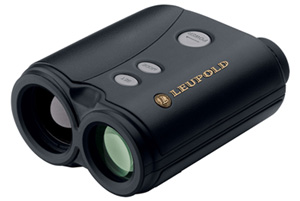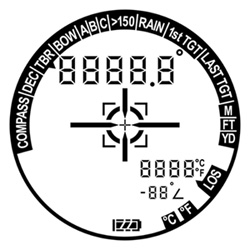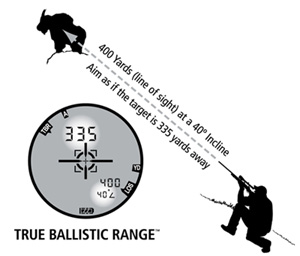|
Leupold RX-III Laser Rangefinder By Chuck Hawks  Leupold & Stevens, the leader in American made riflescopes, has introduced their new RX line of laser rangefinders. The RX line includes the entry level RX-I, medium priced RX-II, and upscale RX-III and RX-IV. The RX-II, RX-III, and RX-IV offer a feature that Leupold calls "True Ballistic Range," and may be the most technologically advanced laser rangefinders in the world at this writing. The RX-III model is the subject of this review. The RX-III combines laser rangefinding with digital electronics, an inclinometer, and ballistic algorithms to deliver True Ballistic Range, the ballistically equivalent range to the target (as well as the conventional line of sight distance measurement, of course). It also includes a built-in thermometer, scan mode, low battery indicator, and Leupold's Match 13 Reticle System. The unit is rated "waterproof," not just "water resistant." Maximum range measurement is rated at 1200 yards on a reflective target, 800 yards on trees, and 700 yards on deer. Accuracy is +/- one yard (or meter). Physically, the RX-III is a medium size rangefinder, too large to fit in a shirt pocket. It measures 4.6x3.5x2 inches and weighs 12 ounces. Like most laser rangefinders but unlike Leupold's riflescopes, which are made in the USA, the RX-III is produced to Leupold's specification in China. It's sad but true that most of the laser rangefinders that I see these days are sourced from the People's Republic of China. (I have tremendous respect for the Chinese people, but I hate to see American dollars funding a Communist government that has clearly and unequivocally stated its long-term intention to destroy the USA, first economically and then by military force. I mean, why are we providing hard currency to a government with those goals?) Our test RX-III arrived well packaged in Leupold's usual attractive manner. In the box was the RX-III, a durable black nylon carrying case, neck strap, instruction manual (a valuable and necessary accessory that every purchaser should read), product registration card (the warrantee period is two years), and an RX quick reference card. The aforementioned case is a nice one, with a good-sized belt loop on the back, a snap swivel, and even a tiny accessory pouch on the side. The quick reference card summarizes the unit's operation and fits in a pocket in the back of the carrying case so that it is easy to keep it handy. A pious idea in the case of this sophisticated rangefinder. On the top of the matte black RX-III is a larger gray "power" button and two smaller gray buttons labeled "mode" and "set." These three buttons are all that is required to program and operate the RX-III. These operating buttons are placed so that they fall naturally under the index, middle, and ring fingers of the right hand. On the bottom of the RX-III is the compartment for the CR2 battery that powers the unit (good for about 2000 actuations) and a 1/4"x20 threaded tripod mounting socket. There is also a very brief summary of the operating instructions printed on the bottom of the unit's rubber armored shell. Clearly, Leupold is trying to do what they can to keep hunters from getting out in the field with an RX-III and being unable to operate the unit. My advice is to keep the Quick Reference card with the rangefinder at all times. That should suffice to get you by even if you forget the fine points of the RX-III's operation. The 8x23mm viewing monocular has an adjustable eyepiece that can be focused to the user's eye--a very important feature. This optic will never be mistaken for half of a Leupold Golden Ring binocular, but it is sufficient for its purpose and provides a better view than the Nikon and Bushnell rangefinders that we happened to have on hand for comparison. The RX-III's various modes and programs are arranged in a circle around the edge of the monocular's field of view, while the actual range information is displayed in the field of view. Leupold calls this a "rotary menu." This arrangement was adopted to reduce the clutter in the central field of view as much as possible.  Illustration courtesy of Leupold & Stevens,Inc. Arranged around the edge (clockwise from left) of the RX-III viewfinder is TBR (selects among the three true ballistic range readout modes--also shows angle of inclination at the "5 o'clock" position in viewfinder when activated); BOW (for selecting the bow hunting ballistic group of three programs); A, B, C (used in combination for selecting one of the seven rifle ballistic programs); >150 (long range mode--only ranges objects beyond 150 yards); RAIN (for ranging in rain or snow); 1st TGT (select to display range to nearest target when beam hits more than one object); LAST TGT (select to display range to most distant target when beam hits more than one object); M, FT, YD (read TBR and line of sight distances in meters, yards, or feet--select one); LOS (when activated displays line of sight distance to target at the "4 o'clock" position in the field of view); F (displays the temperature in Fahrenheit degrees when selected--disables LOS range display); C (displays the temperature in Celsius degrees when selected--disables LOS range display). The Mode button is used to select any of the 13 preloaded reticles as the aiming point for the RX-III rangefinder. Scroll through the reticles and press the Set button to select the reticle of your choice. I found that I preferred the "Bracket Circle with Plus Point" reticle for most ranging, as it is easy to see and occupies less of the field of view than most of the other reticles. To illuminate the display for optimum readability in low-light situations, hold down the Set button. There is also a Clear Field function, which allows you clear all the icons from the field of view without deactivating the various modes or the reticle, distance and angle displays. To clear the field of view, press and hold the Power button, then depress the Mode button for longer than one second. To restore the icons just press Power and Mode simultaneously. I found Clear Field useful for reducing distractions from the field of view and kept it activated while testing and using the RX-III. This is one sophisticated rangefinder. As the Leupold ad copy reads, "Other rangefinders aren't dumb, they're just 'ballistically challenged.'" The RX-III is not "ballistically challenged." It allows measurement of the line of sight distance to the target like an ordinary rangefinder, but also the "true ballistic range" (horizontal distance) if you are shooting up or down hill. And it will give you the firing solution as either the correct distance to hold for (in yards, meters, or feet), or the number of inches (or MOA if you prefer) to hold over or under your target. The latter is based on one of the seven user selected ballistic profiles in the RX-III's memory representing common groups of rifle cartridges. For the bow hunter there are 3 bow groups. For example, in terms of true ballistic range, a target 400 line of sight yards distant up a 40-degree slope is actually 335 horizontal (true ballistic) yards away. To hit, hold for 335 yards, not 400 yards. When in BAS mode the RX-III would display "335" at the top center of the field of view and "400" in smaller numerals at the bottom right (4 o'clock) position. Just below "400" will appear a display showing the angle of inclination, "40 degrees" in this case. (See illustration below.) If we were measuring downhill at the same inclination, the true ballistic and line of sight ranges would be the same, but the angle would be expressed as "-40 degrees."  Illustration courtesy of Leupold & Stevens,Inc. It is easier to use the RX-III than to describe its features and functions. Once the RX-III has been programmed with the features and modes you prefer it operates pretty much like any other laser rangefinder. To make a range measurement, press the power button once to turn the unit on, and a second time to measure the distance to the object centered in the reticle. That is all there is to normal distance measurement. I found that, as near as I could tell, in service the RX-III matched Leupold's range and accuracy specifications. It proved accurate over the measured 25, 50, 100, and 200 yard distances at our local rifle range, and agreed with my Nikon "control" rangefinder over unknown distances out to the maximum range that could measured by both units. (The Leupold RX-III offers considerably greater maximum range capability than my Nikon.) I checked the discount retail price of the RX-III online at Midway USA and found that (in June of 2006) it sold for $399.99. For comparison, a 7x Leica Rangemaster 1200 sold for $589.99, and a 7x Bushnell Elite 1500 with ARC (angle range compensation) sold for $499.00. The 7x Bushnell Elite 1500 without ARC sold for $398.99, or essentially the same price as the 8x RX-III with True Ballistic Range capability. Seen in that light, the Leupold RX-III is not only a top brand, state of the art digital laser rangefinder, but also a heck of a good value. |